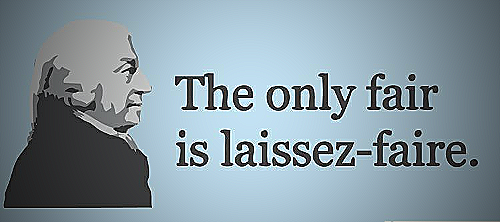Laissez-Faire: The Pros and Cons in 2023
Laissez-faire is an economic theory from the 18th century that opposed any government intervention in business affairs, supporting free-market capitalism. The term comes from the French phrase meaning “let do” or “let it be.”
In essence, it advocates for minimal or no regulation or interference by the government in economic activities, allowing businesses and individuals to operate freely and make their own decisions without external constraints. This approach assumes that the invisible hand of the market will naturally regulate and optimize the economic performance of a society, leading to prosperity and innovation.
However, the application of laissez-faire has been controversial, with critics arguing that it can lead to monopolies, inequality, environmental degradation, and other negative consequences.
Check out this Youtube video on “What is Laissez Faire?” to gain a better understanding of this economic concept and its impact on society.
Etymology and Usage
Laissez-faire is a term of French origin that directly translates to “let do” or “let it be.” It became popular in the 18th century as a political principle that advocates for minimal government intervention in economic affairs.
The laissez-faire theory has been widely used in economics, especially in free-market capitalism, as a belief that the economy can function best when left to its natural forces without any government regulation or control. Under this policy, businesses are free to operate and compete with minimal restrictions, and individuals are encouraged to pursue their own self-interest.
History
Laissez-Faire in Europe
Laissez-faire, which translates to “allow to do,” is an economic theory from the 18th century that opposed any government intervention in business affairs. In Europe, the policy of minimal government interference in the economy had a profound effect on economic growth during the Industrial Revolution.
Countries such as Britain and France embraced laissez-faire policies and experienced strong economic growth.
Laissez-Faire in the United States
The United States adopted laissez-faire policies in the late 19th century, during the Gilded Age, and into the early 20th century. The policy of minimum governmental interference in the economy gave businesses more freedom and autonomy from government regulations.
This allowed companies to invest in the economy and take risks, which led to further economic growth. However, critics argued that laissez-faire policies contributed to inequality and the exploitation of workers.
Models
Free-market Capitalism
Free-market capitalism is an economic system where the government has no or minimal intervention in the market. In this system, businesses are given more autonomy from government rules and regulations, making it easier for companies to take risks and invest in the economy.
Prices of goods and services are determined by the supply and demand of the market, which creates competition among businesses.
In free-market capitalism, individuals and businesses have the freedom to produce and distribute goods and services. This system encourages innovation and creativity in businesses because they are motivated by profit.
However, critics of free-market capitalism argue that it creates income inequality, allowing big businesses to dominate the market and exploit workers.
Socialism
Socialism is an economic system where the government controls all legal production and distribution decisions, and individuals depend on the state for food, healthcare, employment, and other necessities. It aims to create a society where wealth and resources are more evenly distributed among the people.
The impact of socialism on economic growth and development has been the subject of debate for decades. Some argue that it can lead to inefficiency in the economy because businesses lack the motivation to innovate and compete due to the lack of profit incentives.
In this system, everything is controlled by the government, which can lead to bureaucracy, corruption, and slow economic growth.
On the other hand, supporters of socialism argue that it can lead to a fairer society with less income inequality, allowing people to have equal access to resources and opportunities.
The Pros of Laissez-Faire
Efficiency and Innovation
In a laissez-faire economy, businesses have more autonomy and freedom to make their own decisions without excessive government regulation. This promotes efficiency by reducing bureaucratic obstacles and promoting competition, leading to improved innovation and technological advancements.
Individual Freedom and Responsibility
Laissez-faire policies promote individual freedom and responsibility. In a free-market economy, individuals are able to make their own choices and take responsibility for their own success or failure.
This encourages entrepreneurship and personal growth, leading to a healthier economy overall.
Lower Taxes and Less Government Spending
Lower taxes and less government spending are key benefits of laissez-faire policies. With less government intervention and regulation, there are fewer bureaucratic expenses and less need for taxpayer funding.
This allows individuals and businesses to keep more of their hard-earned money and use it for productive purposes.
The Cons of Laissez-Faire
Income Inequality and Social Stratification
While laissez-faire policies give businesses more autonomy and freedom from regulatory government oversight, it can lead to inequality of income and wealth. This inequality can perpetuate a vicious cycle, with inheritance playing a key role in financial placement within society.
People who are not well-off to begin with struggle to make upward economic mobility, leading to social stratification.
Market Failure and Externalities
Laissez-faire economies operate on the principle of supply and demand. In such a system, where the market is allowed to self-regulate, there can be instances of market failure where the market does not allocate resources efficiently.
Additionally, externalities like pollution and the exploitation of natural resources can persist because of the lack of government intervention.
Instability and Crises
The absence of government intervention in the economy places businesses in more precarious positions. In a laissez-faire economy, there are higher chances of economic instability and crises.
Without government oversight, companies can take advantage of the market and engage in risky behavior that can lead to financial crises.
Counterarguments
While laissez-faire policies have their benefits, they also face some common counterarguments. One argument is that without government regulation, businesses are free to exploit workers and consumers.
This could lead to unsafe working conditions, environmental damage, and monopolies that limit competition.
Another common counterargument is that laissez-faire policies could exacerbate income inequality. When businesses are free to operate without government intervention, they may prioritize profits over fair wages for workers or investment in social programs.
This could lead to a cycle where the wealthy control a disproportionate amount of resources and opportunities.
Finally, critics argue that laissez-faire policies could lead to economic instability. Without government oversight, businesses may take excessive risks or engage in speculative activities that could result in economic bubbles and crashes.
While there are valid counterarguments to laissez-faire policies, proponents argue that when businesses are freed from excessive government intervention, they can thrive and contribute to a healthy economy. The key is finding a balance between regulation and freedom that promotes fair competition and protects workers and consumers.
Examples
Laissez-faire policies have been implemented throughout history with varying degrees of success. One example is the Industrial Revolution in Great Britain, where laissez-faire policies contributed to the growth of entrepreneurship and innovation.
However, this also led to poor working conditions and exploitation of workers.
In the early 20th century, the United States implemented laissez-faire policies that allowed for the rise of monopolies, such as Standard Oil and J.P. Morgan’s banking empire. These monopolies had immense power and control over the economy, leading to corruption and unequal distribution of wealth.
More recently, laissez-faire policies have been implemented in countries such as Chile, where strict deregulation and privatization policies were put in place. While this led to a rapid growth of the economy, it also led to income inequality and poverty among the lower classes.


